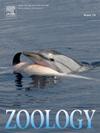种内机械和化学信号在雄蝎和雌雄识别中的作用。
IF 1.6
3区 生物学
Q2 ZOOLOGY
引用次数: 0
摘要
疏水化合物存在于陆生节肢动物的表皮蜡层(CWL)中,保护它们免受脱水,并参与化学通讯。然而,CWL化合物在蝎子行为生态学中的作用研究较少,大多数研究集中在它们对机械刺激的反应上。在本研究中,我们旨在表征Tityus pusillus (Scorpiones, Buthidae)的CWL组成,并研究CWL溶剂提取物和运动对该物种雄性的种内交配和性别识别的影响。采用气相色谱-质谱联用技术(GC-MS)分析了成虫雌虫和雄虫的CWL己烷提取物。在实验场地内的配对行为测试中,我们将成年雄性暴露于i)活的和完整的死雌性;ii)完整的死雌鱼及没有白斑的雌鱼(用溶剂清洗去除);iii)完整的雄性尸体,无论有无CWL。研究结果表明,雌性和雄性山菖蒲的CWL提取物均含有一系列线性烷烃(C21 ~ C34;> 54 %相对组成),以及脂肪酰基(> 9.5 %)和甲基支链烷烃(> 9.1 %)。两种未分配的C31单甲基支链烷烃仅在男性CWL提取物中被鉴定出来(~ 4.7 %),而女性样品中含有较高的相对浓度(> 22.5 %)的甾醇衍生物,仅在男性样品中作为次要成分存在。无论是与活着的雌性还是死去的雌性配对,无论是完整的还是没有CWL的,雄T. pusillus都表现出性取向的行为。然而,他们忽略了同地域的雄性死亡。我们的研究结果表明,CWL化合物在雄瓢虫种内的性别识别中起作用,但仅CWL化合物不能解释配偶识别。本文章由计算机程序翻译,如有差异,请以英文原文为准。
The role of intraspecific mechanical and chemical signaling for mate and sexual recognition in male Tityus pusillus (Scorpiones, Buthidae)
Hydrophobic compounds present in the cuticular wax layer (CWL) of terrestrial arthropods protect them from dehydration and are also involved in chemical communication. However, the role of CWL compounds in the behavioral ecology of scorpions has been studied less often, with most investigations focusing on their responses to mechanical stimuli. In this study, we aimed to characterize the CWL composition of Tityus pusillus (Scorpiones, Buthidae) and examine the influence of CWL solvent extracts and movement on intraspecific mate and sexual recognition by males of this species. We analyzed CWL hexane extracts of adult female and male T. pusillus by gas chromatography-mass spectrometry (GC-MS). In paired behavioral tests inside an experimental arena, we exposed adult males to i) live and intact dead conspecific females; ii) intact dead females and females without the CWL (removed with solvent washes); and iii) intact dead males with and without the CWL. Our results showed that CWL extracts of both female and male T. pusillus contained a series of linear alkanes (C21 – C34; > 54 % relative composition), as well as fatty acyls (> 9.5 %) and methyl-branched alkanes (> 9.1 %). Two unassigned C31 monomethyl-branched alkanes were exclusively identified in male CWL extracts (∼ 4.7 %), while female samples contained high relative concentrations (> 22.5 %) of sterol derivatives, present only as minor constituents in male samples. Male T. pusillus performed sexually-oriented behavioral acts when paired with both live and dead conspecific females, intact or without the CWL. However, they ignored conspecific dead males. Our results show that CWL compounds have a role in intraspecific sexual recognition by male T. pusillus but only the CWL compounds does not explain mate recognition.
求助全文
通过发布文献求助,成功后即可免费获取论文全文。
去求助
来源期刊

Zoology
生物-动物学
CiteScore
3.90
自引率
0.00%
发文量
37
审稿时长
70 days
期刊介绍:
Zoology is a journal devoted to experimental and comparative animal science. It presents a common forum for all scientists who take an explicitly organism oriented and integrative approach to the study of animal form, function, development and evolution.
The journal invites papers that take a comparative or experimental approach to behavior and neurobiology, functional morphology, evolution and development, ecological physiology, and cell biology. Due to the increasing realization that animals exist only within a partnership with symbionts, Zoology encourages submissions of papers focused on the analysis of holobionts or metaorganisms as associations of the macroscopic host in synergistic interdependence with numerous microbial and eukaryotic species.
The editors and the editorial board are committed to presenting science at its best. The editorial team is regularly adjusting editorial practice to the ever changing field of animal biology.
 求助内容:
求助内容: 应助结果提醒方式:
应助结果提醒方式:


